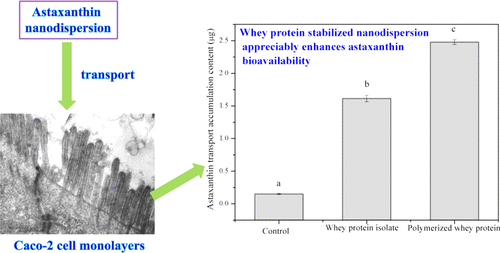当前位置:
X-MOL 学术
›
J. Agric. Food Chem.
›
论文详情
Our official English website, www.x-mol.net, welcomes your
feedback! (Note: you will need to create a separate account there.)
Physicochemical Properties of Whey-Protein-Stabilized Astaxanthin Nanodispersion and Its Transport via a Caco-2 Monolayer
Journal of Agricultural and Food Chemistry ( IF 5.7 ) Pub Date : 2018-01-30 00:00:00 , DOI: 10.1021/acs.jafc.7b05284 Xue Shen 1 , Changhui Zhao 1 , Jing Lu 1 , Mingruo Guo 1, 2, 3
Journal of Agricultural and Food Chemistry ( IF 5.7 ) Pub Date : 2018-01-30 00:00:00 , DOI: 10.1021/acs.jafc.7b05284 Xue Shen 1 , Changhui Zhao 1 , Jing Lu 1 , Mingruo Guo 1, 2, 3
Affiliation

|
Astaxanthin nanodispersion was prepared using whey protein isolate (WPI) and polymerized whey protein (PWP) through an emulsification–evaporation technique. The physicochemical properties of the astaxanthin nanodispersion were evaluated, and the transport of astaxanthin was assessed using a Caco-2 cell monolayer model. The astaxanthin nanodispersions stabilized by WPI and PWP (2.5%, w/w) had a small particle size (121 ± 4.9 and 80.4 ± 5.9 nm, respectively), negative ζ potential (−19.3 ± 1.5 and −35.0 ± 2.2 mV, respectively), and high encapsulation efficiency (92.1 ± 2.9 and 93.5 ± 2.4%, respectively). Differential scanning calorimetry curves indicated that amorphous astaxanthin existed in both astaxanthin nanodispersions. Whey-protein-stabilized astaxanthin nanodispersion showed resistance to pepsin digestion but readily released astaxanthin after trypsin digestion. The nanodispersions showed no cytotoxicity to Caco-2 cells at a protein concentration below 10 mg/mL. WPI- and PWP-stabilized nanodispersions improved the apparent permeability coefficient (Papp) of Caco-2 cells to astaxanthin by 10.3- and 16.1-fold, respectively. The results indicated that whey-protein-stabilized nanodispersion is a good vehicle to deliver lipophilic bioactive compounds, such as astaxanthin, and to improve their bioavailability.
中文翻译:

乳清蛋白稳定的虾青素纳米分散体的理化性质及其通过Caco-2单层的转运。
虾青素纳米分散体是使用乳清蛋白分离物(WPI)和聚合乳清蛋白(PWP)通过乳化-蒸发技术制备的。评估虾青素纳米分散体的理化性质,并使用Caco-2细胞单层模型评估虾青素的转运。WPI和PWP(2.5%,w / w)稳定的虾青素纳米分散体具有较小的粒径(分别为121±4.9和80.4±5.9 nm),负ζ电位(分别为-19.3±1.5和-35.0±2.2 mV) )和高封装效率(分别为92.1±2.9和93.5±2.4%)。差示扫描量热曲线表明两种虾青素纳米分散体中均存在无定形虾青素。乳清蛋白稳定的虾青素纳米分散体显示出对胃蛋白酶消化的抵抗力,但在胰蛋白酶消化后易于释放虾青素。当蛋白质浓度低于10 mg / mL时,纳米分散体对Caco-2细胞无细胞毒性。WPI和PWP稳定的纳米分散体改善了表观渗透系数(P应用程序通过10.3-和的Caco-2细胞对虾青素)16.1倍,分别。结果表明,乳清蛋白稳定的纳米分散体是递送亲脂性生物活性化合物(如虾青素)并提高其生物利用度的良好载体。
更新日期:2018-01-30
中文翻译:

乳清蛋白稳定的虾青素纳米分散体的理化性质及其通过Caco-2单层的转运。
虾青素纳米分散体是使用乳清蛋白分离物(WPI)和聚合乳清蛋白(PWP)通过乳化-蒸发技术制备的。评估虾青素纳米分散体的理化性质,并使用Caco-2细胞单层模型评估虾青素的转运。WPI和PWP(2.5%,w / w)稳定的虾青素纳米分散体具有较小的粒径(分别为121±4.9和80.4±5.9 nm),负ζ电位(分别为-19.3±1.5和-35.0±2.2 mV) )和高封装效率(分别为92.1±2.9和93.5±2.4%)。差示扫描量热曲线表明两种虾青素纳米分散体中均存在无定形虾青素。乳清蛋白稳定的虾青素纳米分散体显示出对胃蛋白酶消化的抵抗力,但在胰蛋白酶消化后易于释放虾青素。当蛋白质浓度低于10 mg / mL时,纳米分散体对Caco-2细胞无细胞毒性。WPI和PWP稳定的纳米分散体改善了表观渗透系数(P应用程序通过10.3-和的Caco-2细胞对虾青素)16.1倍,分别。结果表明,乳清蛋白稳定的纳米分散体是递送亲脂性生物活性化合物(如虾青素)并提高其生物利用度的良好载体。











































 京公网安备 11010802027423号
京公网安备 11010802027423号